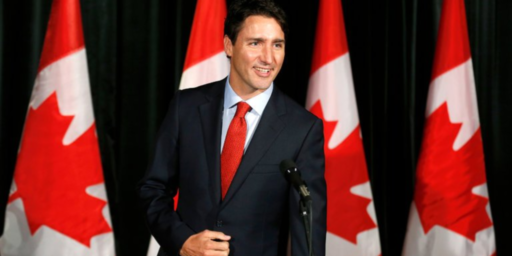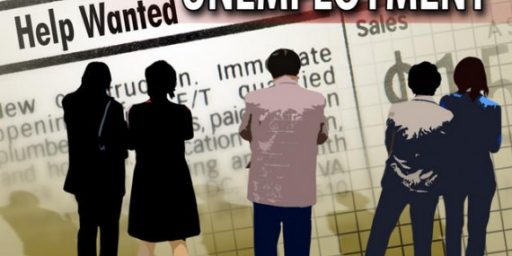The Real Unemployment Rate
Yesterday in The Financial Times, Ed Luce hits on a point that I made when the most recent unemployment figures were released two weeks ago, namely that the unemployment figures that are shared publicly are vastly understating the real unemployment rate:
America is employing a decreasing proportion of its people. At the start of the recession, the employment-to-population rate was 62.7 per cent. The rate is now 58.5 per cent. Last month, unemployment fell from 9 per cent to 8.6 per cent. On the surface, this looked like a welcome leap in job creation. In reality, more than half of the fall was accounted for by a decrease in the numbers “actively seeking” work. The 315,000 who dropped out of the labour market far exceeded the 120,000 new jobs.
According to government statistics, if the same number of people were seeking work today as in 2007, the jobless rate would be 11 per cent. Some have moved from claiming unemployment benefits to disability benefits, and have thus permanently dropped out of the labour force.
We’ve hit on this before at OTB so it’s really not a surprise and, as Ezra Klein points out, the paradoxical result of the manner in which the government calculates unemployment is that it the jobs situation will appear to get worse even as the economy improves:
If 62.7 percent of the country was still counted as in the workforce, unemployment would be 11 percent. In that sense, the real unemployment rate — the apples-to-apples unemployment rate — is probably 11 percent. And the real un- and underemployed rate — the so-called “U6” — is near 20 percent.
There were some celebrations when the unemployment rate dropped last month. But much of that drop was people leaving the labor force. The surprising truth is that when the labor market really recovers, the unemployment rate will actually rise, albeit only temporarily, as discouraged workers start searching for jobs again.
It turns out, though, that the unemployment situation is actually worse than that, and the only reason we’re not noticing it yet is because of the demographic changes taking place in the population:
The current unemployment rate of 8.6 percent hides the extent of the economic crisis. The widely quoted rate misses not only the under-employed and discouraged workers, but also major demographic factors.
The large demographic shift that has taken place over the last few decades—driven by the maturing of the baby boom generation—now places considerable downward pressure on the unemployment rate, which makes the current malaise look a bit better than it really is.
As people (especially men) age into their thirties and forties they tend to hold onto jobs for longer, in part because they’ve usually acquired a modicum of useful skills and education, as well as a host of familial obligations that make working somewhat of an imperative. As a result, the unemployment rate for 30-somethings and 40-somethings tends to be quite low.
(…)
Economists attempt to account for these demographic forces by using a measure called the D.O.U.R.—or the Demographically-Adjusted Unemployment Rate. Recent work by Marianna Kudlyak, Devin Reilly, and Steven Slivinski of the Richmond Fed suggest that the demographic factors present in today’s economy may be suppressing the unemployment rate as much as 1 percentage point—meaning that without the current mix of old and young people we would be facing an unemployment rate nearing 10 percent.
(…)
The demographic effect we see suppressing the unemployment rate today will slowly dissipate as the baby boomers retire. And when this time comes we will either need to come to grips with a higher natural unemployment rate—which is not by itself a disaster—or else think more creatively about how to make young people’s transition into the job market easier.
But the fundamental short-term implication of factoring demographics into the equation is that, but for the plethora of aging boomers on the verge of retirement, the overall economic picture would be even worse.
At the very least, this stands as a reminder that the monthly statistics we get from the Bureau of Labor Statistics aren’t telling anything close to the whole story, and that we’re likely to be dealing with the effects of long-term high unemployment for much longer than many people are willing to admit.






And thus it has always been…so really…what’s your point?
How about a little context…what was the real unemployment when Bush left office and we were bleeding over 600,000 jobs a month?
Has this administration done anything to change procedures to make themselves look better? Because both Reagan and Clinton did.
And most importantly…can you name a similar economy in a similar hole recovering any faster? Or are you simply wishing for unicorns?
Obama on 60 Minutes just two days ago:
So your statement that
just isn’t very accurate is it?
Nevermind U6, which is the real unemployment and under-employed rate. That rate is 15.7% and is a measure of people who are either out of the job market but willing to work or folks stuck in temp jobs who would like full-time employment. I say they should find some bootstraps!
It might be good to reference:
Table A-15. Alternative measures of labor underutilization
It’s interesting that the jump from U5 to U6 is 5%. That’s the number of involuntary part-timers.
This doesn’t quite make sense to me. As huge numbers of boomer retire, isn’t that going to put further downward pressure on unemployment as businesses will have hire replacements?
@Stormy Dragon: The rate should go down some, but so will wages, as highly-experienced retirees are replaced with younger, probably-desperate workers. And as average wages have been pretty much flat since the late 70s, the economy will not improve.
Note to businesses: you can’t sell things to people who don’t have any money.
@Hey Norm: Are you seriously going to quote that line, when it’s been so disproven?
@Jeremy Kolassa:
I don’t think that’s a disproof. You are saying the Pres should have overruled his economists and put in more pessimistic numbers.
Seriously?
Economists are often wrong, and whether they are right or wrong, they “flock.” Better to do as the Pres probably did, and let them do their thing, while not taking it terribly seriously.
Related reading:
The Neuroeconomics Revolution
Macroeconomics never claimed to be perfect, but turned out to be even less than promised.
@ Jeremy…
What you and the uber-partisan website, Hot Air, neglect to mention/consider/acknowledge is that the estimates of the Bush Contraction…which all the economic forecasts were based on at the time…were all off by a huge amount.
Output in the third and fourth quarters fell by 3.7% and 8.9%, respectively, not at 0.5% and 3.8% as was believed at the time. Employment was also falling much faster than estimated. Some 820,000 jobs were lost in Bush’s last month in office, rather than the 598,000 then reported. In the three months prior to the passage of stimulus, the economy cut loose 2.2m workers, not 1.8m. In January, total employment was already 1m workers below the level shown in the official data.
Those are huge errors…the economy Bush and pseudo-conservative rightist policies left behind was not just a bad recession…it was cataclysmic….much, much worse than anyone knew at the time. The Obama administration stopped the economic slide, but if the recovery seems slow to you it’s because no one knew…and couldn’t know…just how catastrophic the mess they inherited from the Bush/Cheney really was.
Bottom line…the facts just do not match your dogma.
Hot Air…Michelle Malkin and Ed Morrisey…give me a break.
It is hard to wrap ones head around exactly what all these various measures really mean That is why most people simply use the reported unemployment rate and compare it to the same rate that they experienced in other times. All the factors about discouraged workers, or involuntary part-timing etc. were around at other times. If you are going to dredge up and discuss all the other measures, then you need to explore what those other measures said in other times, so similar comparisons can be made.
@Hey Norm: No one knew except you apparently, perhaps you should pull on your boots and go teach people a thing or two with all of the hot air you are blowing. Its obvious that there are way more factors to take into account than what is reported, but then that requires one to look at things with perspective and not view the world or the economy in this instance through the rose colored glasses that the Democrats and Republicans provide to each of their loyal servants such as you. Politicians lie its what they do even the President that you are so adamantly going to bat for.
@ Chuck…
Not a lot of facts or specifics in your comment…just emotional ranting.
And thus it has always been…